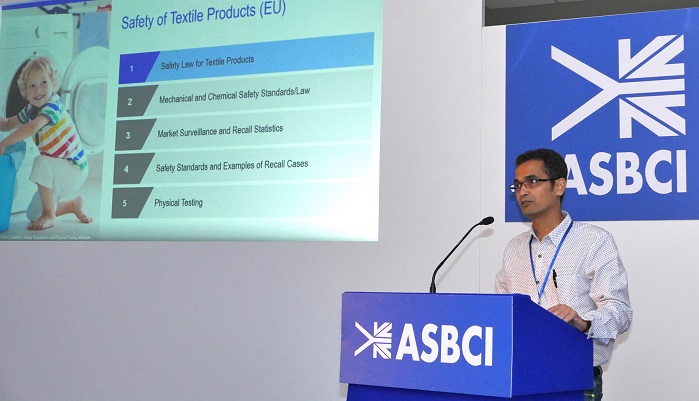
M&S joins expert speaker line-up at ASBCI seminar
The ASBCI’s latest technical seminar opened with a comprehensive overview of product safety regulations from the keynote speaker.

7th October 2019
Knitting Industry
|
Halifax

Hazard assessment workshop. © ASBCI
The importance of hazard identification in product design, understanding foreseeable use, and mitigating the commercial risks of global supply chains were just some of the topics discussed at the interactive and educational technical seminar on effective risk management organised last month by the ASBCI and sponsored by TÜV SÜD.
The ASBCI’s latest technical seminar opened with a comprehensive overview of product safety regulations from keynote speaker Sheikh Minhazuddin, Deputy General Manager for R&D, Technical Governance and Regulatory Compliance at TÜV SÜD.
Mr Minhazuddin discussed the responsibilities of product manufacturers with regards to putting safe products on the market, particularly childrenswear. He looked at recall statistics, identifying the most common reasons for product recalls – strangulation, choking, and chemical hazards – and detailed relevant standard updates. He also addressed specific risks in depth, explaining the hazards of certain design features and product categories and what can be done by industry to reduce the number of incidents.
Sarah Anderson from M&S provided a detailed look at the importance of hazard assessment to control risk in childrenswear and explained why an understanding of child development is the starting point for developing safe products. Sarah ran through the different stages of development and the hazards associated with the exploration strategies children use – from choking and strangulation to suffocation, ingestion, insertion, laceration, irritation, restriction of vision, and toxicity – as well as possible mitigation strategies.
Industry consultant Geraldine Cosh delivered an entertaining presentation that focused on giving delegates the knowledge and tools to conduct both risk and hazard assessments effectively. She explained how multiple resources should be used to identify potential hazards, including injury databases, social media, and recall reports, and how these combine to determine foreseeable use. “If someone is doing it on Youtube, it is a foreseeable use. Then you have to ask yourself: is it reasonable, and do you have to mitigate it?”

Keynote speaker Sheikh Minhazuddin, TÜV SÜD. © ASBCI
Building on this, Ms Cosh led an interactive workshop session in the afternoon, which challenged delegates to conduct a hazard assessment on a variety of products, including a mermaid tail, a baby’s sleepsuit, a sequinned top, and a pair of summer shoes, ultimately asking: would you sell this product? In addition to discussing the hazards identified during the exercise, Ms Cosh encouraged the groups to think about ways in which these could be designed out and whether the issues amounted to non-compliance or simply an unsatisfactory product.
Geoffrey Willis, international senior apparel industry specialist from Trigon, focused on the commercial risks facing fashion brands in the era of offshore sourcing, particularly the loss of control over manufacturing and the consequent loss of manufacturing knowledge among buyers. He argued that the most effective strategy to combat sourcing risks is to ensure you have a thorough understanding of the capabilities of factories and outlined an assessment method that covers everything from facilities and processes, production performance and planning to quality, human resources, materials sourcing, and service. “You wouldn’t buy a house without a survey, so why would you use a factory without doing this?” he said.
The day concluded with a Q&A session. Delegates put their questions to an expert panel, which included the seminar speakers and risk assessment experts Alan Ross from HSTTS/MTS and Ian Strudwick from Shirley Technologies. Questions ranged from how to use product safety standards and guidance documents, reconciling the need for constant innovation with product safety, and the point at which foreseeable use becomes misuse. “People will always find stupid things to do with products,” said Ms Cosh. “If you found yourself in court, would you feel comfortable saying you had done everything you could?”
“We are delighted at the success of this seminar and its more interactive format,” said ASBCI Chairman Alistair Knox. “In addition to excellent presentations from our expert speakers, we saw active and animated discussion among delegates in the workshop session, and a lively Q&A. There was a recognition that everyone shares the same problem – the challenge of creating a product that will do no harm – and it was a great networking opportunity for everyone involved.”
The next technical seminar will be on 26 November and will provide an update on ZDHC, looking beyond 2020.

Business intelligence for the fibre, textiles and apparel industries: technologies, innovations, markets, investments, trade policy, sourcing, strategy...
Find out more